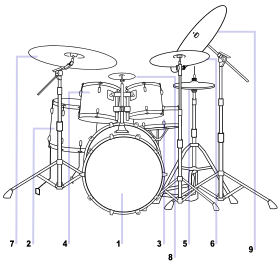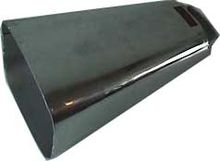Cowbell (instrument)
| The drum kit |
|---|
 |
| Not shown |
| See also |
You must add a |reason= parameter to this Cleanup template – replace it with {{Cleanup|August 2005|reason=<Fill reason here>}}, or remove the Cleanup template.

The cowbell is a percussion instrument.
Background
While the cowbell is commonly found in musical contexts, its origin can be traced to freely roaming animals. In order to help identify the herd to which these animals belonged herdsmen placed these bells around the animal's necks. As the animals moved about the bell would ring, thus making it easier to know of the animal's whereabouts. While bells may used on various types of animals, they are typically refered to as "cowbells" due to their extensive use with cattle. Cowbells are commonly trapezoid, cylindrical or cup-shaped.
As a musical instrument
Greek herdsmen often use several bells attached to principal animals which produce a distinctive chord. The scale on which this chord is based is then reproduced in the herdsman's pipe - so he can play along with the herd. Similar bells have been used in Western European "Classical" music to evoke a pastoral mood.
Clapperless cowbells made of metal are an important element in Latin-American and go go music. These cowbells are struck with a stick - the tone being modulated by striking different parts of the bell and by damping with the hand holding the bell.
In several parts of the world (notably in West Africa) pairs or trios of clapperless bells are joined in such a way that they can be struck separately or clashed together. The Brazilian name for these is "agogo" bells. Cylindrical wood blocks played in the same way are also called "agogo". In Cuban music the cowbell is called cencerro and often played by the same player as the bongos, which has led to bongo players being called bongocerros.
Many popular recordings have featured the cowbell, including War's "Low Rider"; The Beatles' "Taxman", "A Hard Day's Night", and "Drive My Car"; Mountain's "Mississippi Queen", Bachman Turner Overdrive's "You Ain't Seen Nothin' Yet", Free's "All Right Now", Yes's "Owner of a Lonely Heart" and Loverboy's "Working for the Weekend." The cowbell was also the subject of a famous Saturday Night Live skit popularly known as "More Cowbell."
The Roland TR-808 drum machine was noted for its distinctive cowbell sound, which sounded almost nothing like an actual cowbell; the sound was highly electronic with a sharp, short decay. Regardless of its lack of realism, the TR-808 cowbell became a popular sound in 1980s R&B and hip hop music, popularized by Jimmy Jam & Terry Lewis-produced artists such as The SOS Band and Janet Jackson. Its distinctive and notorious timbre, although completely different from the sound of typical cowbells, has enjoyed continued use by hip hop and R&B artists well into the 1990s and 2000s, as well as by bands in other genres such as the Super Furry Animals ("Juxtaposed With U") and the Dismemberment Plan ("You Are Invited").
As noisemakers
Cowbells are sometimes popular noisemakers at sporting events, despite attempts to suppress them. In the United States, they are most closely identified with Mississippi State University, whose football fans smuggle in cowbells by the thousands despite a ban on artificial noisemakers by its conference, the Southeastern Conference. Cornell ice hockey fans who are also known for their zealous support of their team have cheers that feature use of a cowbell while in Lynah Rink. The San Jose SaberCats of the Arena Football League are also (in)famous for their fans' use of cowbells. In New Zealand, supporters of the Waikato Rugby Union invariably use cowbells at home matches; this has been carried over to home matches of the Chiefs, the Super 14 franchise centered on the Waikato region.
